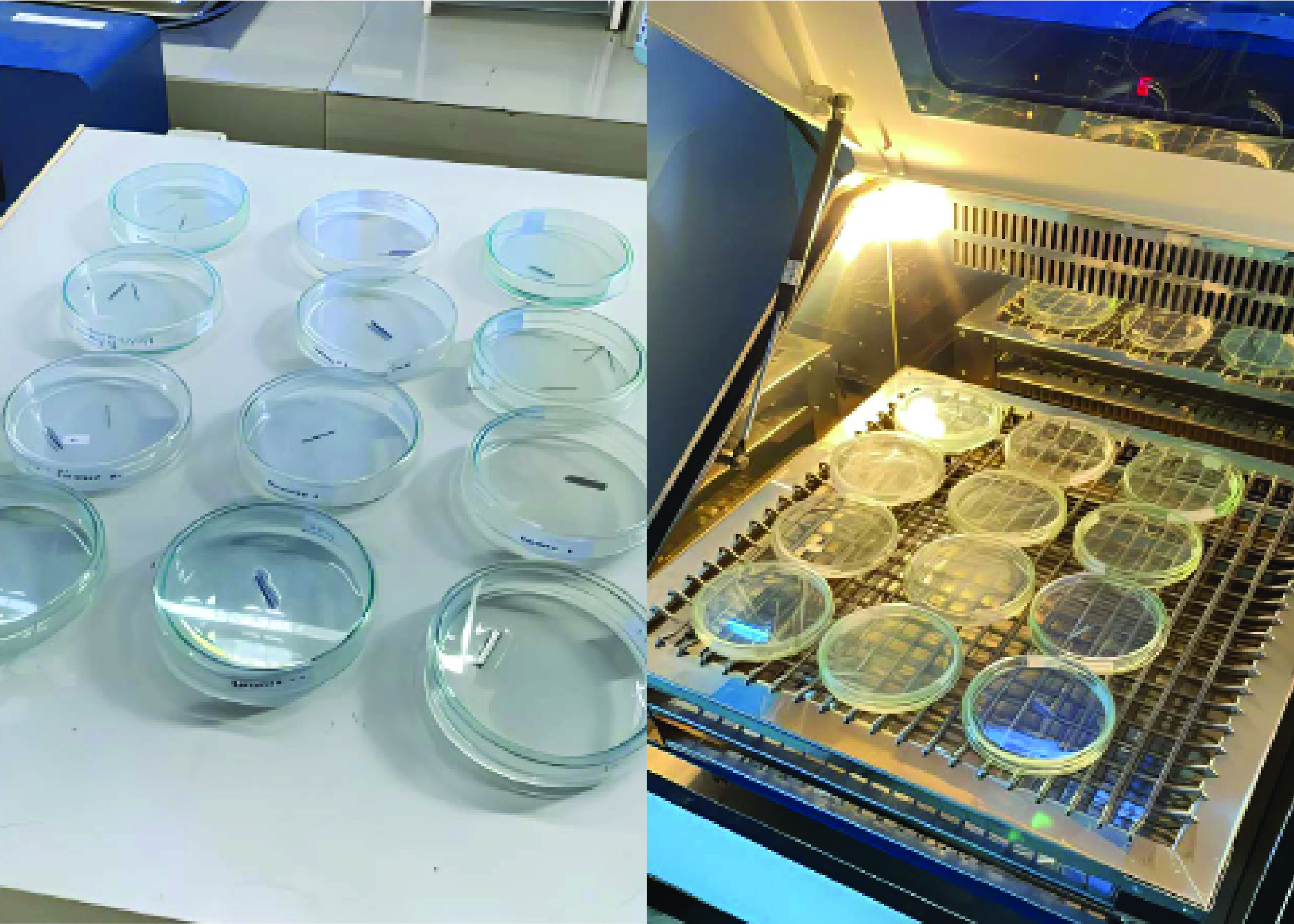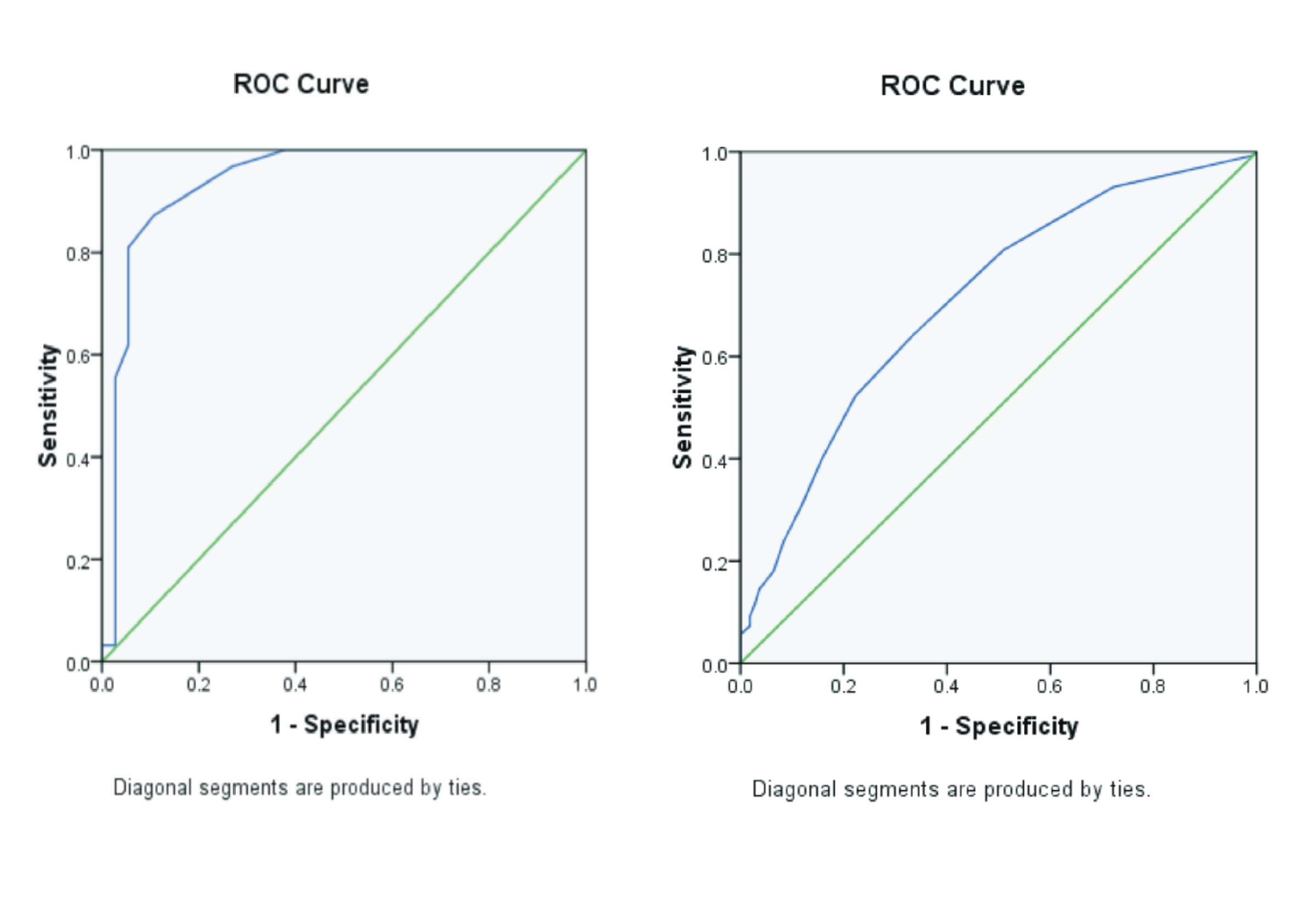THE POTENTIAL EFFECT OF AVOCADO SEED EXTRACT (PERSEA AMERICANA) AS A CORROSION INHIBITOR ON SURFACE CHARACTERISTIC OF ORTHODONTIC WIRES

Background: The surface roughness of orthodontic arch wires is an essential factor that affects the effectiveness of arch-guided tooth movement. Metal wires exposed to the oral cavity environment are susceptible to corrosion. The corrosion process cannot be stopped but can be inhibited using natural inhibitors that contain antioxidant compounds, such as tannins found in avocado seeds. Tannins in avocado seed extract can act as a corrosion inhibitor through two working mechanisms, a passive layer and an adsorption process. Purpose: The aim of this study was to examine the viability of avocado seed extract as a corrosion inhibitor on the surface characteristic of orthodontic wires. Method: This research is an experimental laboratory research. A total of 48 orthodontic wires (stainless steel, nickel titanium, and Titanium-Molybdenum Alloy (TMA)) were prepared and divided into control and treatment groups. The treatment groups were immersed in avocado seed extract at concentration of 1.5 g/L (T-1), 2 g//L (T-2) and 2.5 g/L (T-3) for 7 days with twice daily immersion of 1 minute each. A TR 220 surface roughness tester (ΔRa) was used to evaluate surface characteristic. The data was analyzed using the one-way ANOVA test followed by post hoc LSD test with a significance value of p-value < 0.05. Result: The average surface roughness increased in all control groups except for stainless steel wire which did not show a significant difference with p-value = 0.716. Furthermore, the difference test between groups on each wire showed different results. Conclusion: Avocado seed extract is effective as a corrosion inhibitor for orthodontic wires.
Introduction
The surface topography of orthodontic wires is a basic characteristic known to affect their mechanical properties, the biocompatibility and corrosion resistance. Increased surface roughness of orthodontic wires can influence the coefficient of friction, which in turn affects how effective sliding the biomechanics works and the efficiency of sliding mechanics and the overall effectiveness of orthodontic appliances(Ashique Abdulhameed et al., 2024).
Orthodontic wires provide force to move teeth back into the proper arch alignment, enabling proper occlusion(Arora et al., 2019). Several types of orthodontic wires that can be used in the orthodontic treatment, consist of Stainless Steel (SS), Nickel Titanium (NiTi), and Titanium-Molybdenum Alloy (TMA) wires(Nimeri et al., 2013). Stainless steel wires primarily consist of Fe ions at 71%. Nickel titanium wire has a composition of 55% nickel ions and 45% titanium ions, and TMA wire contains 77.8% titanium, 11.3% molybdenum, 6.6% zirconia, and 4.3% tin(Brantley & Eliades, 2011).
The mechanical properties of orthodontic wires are exceptionally critical since they greatly influence the viability of orthodontic treatment. Basic mechanical properties such as modulus of versatility, abdicate quality, and fracture toughness. Additionally, orthodontic wires must be resistant to corrosion(Zinelis et al., 2015). However, orthodontic treatment is a long-term procedure, orthodontic wires are potentially subject to ion release due to prolonged contact with saliva(Castro et al., 2015). In artificial saliva with pH 4 - 6, stainless steel and Ni-Ti wires are known to undergo pitting corrosion(Fatene et al., 2019). The consequence of corrosion on orthodontic wire affects its mechanical properties, specifically elastic modulus and yield strength. In addition, the roughness of the wire surface will cause greater friction between the bracket and the wire, which will reduce the sliding action and thus decrease the efficiency of tooth movement during treatment(Sheikh et al., 2015). Corrosion also affects the biocompatibility of the wire. Metal ions released into the oral environment will enter the body and can have health effects such as triggering type 4 hypersensitivity reactions in some patients(Uzer et al., 2016).
Saliva is an electrolyte liquid that facilities electrochemical reactions. In electrochemical reactions, oxidation occurs at the anode (metal surface), and reduction occurs at the cathode. H+ions in saliva. As a result, there is a release of ions in orthodontic wire as a sign of corrosion. The corrosive impact of the artificial saliva-based arrangements is due to the nearness of chloride ions. In environment with sufficient of chloride particles, pitting corrosion can occur, characterized by localized pits forming on the metal surface. This typically occurs in base metals protected by a thin, naturally formed oxide film(Rajendran et al., 2017).
Corrosion inhibitors are chemicals that when when applied in small amounts to metals can decrease corrosion without reacting with the encompassing environment. Corrosion inhibitors can come from extracts of natural materials that contain flavonoids, phenols, steroids, triterpenoids, and tannins with antioxidant activity(Kadhim et al., 2021). Avocado-seed extracts have numerous health-related bioactive properties, such as anti-hyperglycaemic, anticancer, anti-hypercholesterolemia, antioxidant, anti-inflammatory, and anti-neurogenerative impacts are clearly illustrated how these properties can be utilized to define or brace nourishment(Bangar et al., 2022). The extract from avocado seeds (Persea americana) is recognized as a potential corrosion inhibitor. Inside the extract, ethanol acts as solvent, and it contains tannin compounds at a concentration of 0.2044%(Rivai et al., 2019).(Rais & Wahyuningtyas, 2021)found that avocado seed extract with a concentration of 2.5 g/L was effective in reducing the corrosion rate of steel metal. Tannins can hinder the corrosion rate on metal surfaces by acting as a coating and forming a passive layer. The passive layer may be a condition in which the metal loses its reactivity, in this manner improving resistance to the ion release(Adha et al., 2019). The aim of this study was to examine the viability of avocado seed extract as a corrosion inhibitor on the surface characteristic of orthodontic wires with surface roughness measurement.
Material and method
This study was laboratory experimental research with a post-test control group design. The characteristic of surface orthodontic wires were evaluated with based on the average of surface roughness (∆Ra). Samples were used 3 different types of wires consisting of stainless steel, nickel titanium, and TMA wire, from ORMCO Ltd, with size 0.017 × 0.025 inches were prepared with a length of 60 mm. All type of wire were divided into 4treatment groups including control group, treatment 1(T-1 : 1.5 g/L), treatment 2 (T-2 : 2 g/L), and treatment 3 (T3 : 2.5 g/L). Each group according to Daniel's formula consisted of 4 samples. The total for each wire was 16samples and the total for the 4 wire categories was 48 samples.
Figure 1.(a) Soaking the sample in a petri dish, (b) After treatment all samples were stored in an incubator
Processing avocado seed extract
Avocado seeds were dried in a broiler at 40 °C and pulverized to powder form can be seen inFigure 1. The maceration process used 95% ethanol solvent. The ratio of avocado seed powder and solvent is 1 : 10. The final product is thick avocado seed extract. The thick extract of avocado seeds was weighed using a digital analytical balance and then dissolved in 1000 mL of artificial saliva as a corrosive medium, with inhibitor concentrations in each treatment group
Adha, M.A.R., Wibowo, D., Rasyid, N.I., 2019. Gambaran Tingkat Keparahan Maloklusi Menggunakan Handicapping Malocclusion Assessment Record (HMAR) pada Siswa SDN Gambut. Dentin Vol. 3(1), Pp. 1-9.
Angeline, A., Djustiana, N., Nazruddin, N., 2021. Perbedaan Pelepasan Ion Nikel Kawat Ortodonti Stainless Steel yang Direndam dalam Obat Kumur Ekstrak Buah Mengkudu (Morinda citrifolia L. Differences of The Nickel Ions Release of Orthodontic Stainless-Steel Wire Immersed in Various Concentrations of Noni Fruit (Morinda citrifolia L.) Extract Mouthwash. Padjadjaran Journal of Dental Researchers and Students Vol. 5(2), Pp. 110.
Anusavice, K.J., Shen, C., Rawls, H.R., 2012. Phillips’ Science of Dental Materials, 12 th Edition. ed. Saunders.
Arora, P., Garg, H., Bohidar, H., 2019. Surface Topography and Composition of As-Received and Retrieved Initial Archwires: A Comparative Study. World Journal of Dentistry Vol. 10(2), Pp. 144-149.
Ashique Abdulhameed, S., S, B., Sunny, J., Goswami, D.S., Abraham, N., Asha Ambroise, M., 2024. Comparison of Surface Roughness of Different Orthodontic Archwires: Atomic Force Microscopic Study. Cureus Vol. 16(1), Pp. e51516.
ASTM, 2017. Standard Practice for Preparing, Cleaning, and Evaluating Corrosion Test Specimens.
Bangar, S.P., Dunno, K., Dhull, S.B., Kumar Siroha, A., Changan, S., Maqsood, S., Rusu, A.V., 2022. Avocado Seed Discoveries: Chemical Composition, Biological Properties, and Industrial Food Application. Food Chemistry: X Vol. 16, Pp. 100507.
Brantley, W.A., Eliades, T., 2011. Orthodontic Materials: Scientific and Clinical Aspects. Thieme, New York, NY, USA.
Castro, S.M., Ponces, M.J., Lopes, J.D., Vasconcelos, M., Pollmann, M.C.F., 2015. Orthodontic Wires and Its Corrosion - The Specific Case of Stainless Steel and Beta-Titanium. Journal of Dental Sciences Vol. 10(1), Pp. 1-7.
Fatene, Nassiba, Said, M., Elkhalfi Bouchra, Berrada Mohamed, Mounaji Khadija, Soukri Abdelaziz, 2019. Assessment of The Electrochemical Behaviour of Nickel-Titanium-based Orthodontic Wires: Effect of Some Natural Corrosion Inhibitors in Comparison with Fluoride. Journal of Clinical and Experimental dentistry Vol. 11(5), Pp. e414-e420.
Furlan, T., Barbosa, J., Basting, R., 2018. Nickel, Copper, and Chromium Release by CuNi-titanium Orthodontic Archwires is Dependent on The pH Media. Journal of International Oral Health Vol. 10(5), Pp. 224.
Hasyim, H.S., Devi, L.S., Sumono, A., 2016. Pengaruh Perendaman Kawat Nikel-Titanium Termal Ortodonti dalam Minuman Teh Kemasan terhadap Gaya Defleksi Kawat (The Effect of Immersion Thermal Nickel-Titanium Archwire in The Bottled Tea Drinks to The Archwire Force Deflection). Pustaka Kesehatan Vol. 4(2), Pp. 375-380.
Kadhim, A., Al-Amiery, A.A., Alazawi, R., Al-Ghezi, M.K.S., Abass, R.H., 2021. Corrosion Inhibitor. A Review. International Journal of Corrosion and Scale Inhibition Vol. 10(1), Pp. 54-67.
Leni, D., Gunawarman, G., Affi, J., Yetri, Y., 2019. Laju Oksidasi Titanium Murni (Cpti Grade Tipe 340) Berlapis Hydroxyapatite (Ha) yang Disinter dalam Tungku Perlakuan Panas. METAL: Jurnal Sistem Mekanik dan Termal Vol. 3(1), Pp. 46-50.
Mardiah, M., Lapua, E.P., Wahyudiantara, I.P., Iqbal, M., Lestari, I., Rodiyatunnisa, R., Sakinah, N., Novianti, H.L., Fadilah, O.A., 2018. Studi Laju Korosi LogamAluminium dengan Penambahan Inhibitordari Ekstrak Daun Karamunting (Rhodomyrtustomentosa) dalam Larutan NaCl. Jurnal ChemurgyVol. 1(2), Pp. 39-42.
Minami M., Zuisei K., Takahiro W., Toshio H., Hisashi D., Takao H., Takashi O., Motohito U., 2015., Mechanical Properties of Orthodontic Wires Made of Super Engineering Plastic. Dental Materials Journal. Vol 34(1).Pp 114-119.
Mousavi, S.M., Shamohammadi, M., Rastegar, Z., Skini, M., Rakhshan, V., 2017. Effect of Esthetic Coating on Surface Roughness of Orthodontic Archeires. International Orthodontics Vol. 15(3), Pp. 312-321.
Nardeli, J.V., Fugivara, C.S., Taryba, M., Pinto, E.R.P., Montemor, M.F., Benedetti, A.V., 2019. Tannin: A Natural Corrosion Inhibitor for Aluminum Alloys. Progress in Organic Coatings Vol. 135, Pp. 368-381.
Nimeri, G., Kau, C.H., Abou-Kheir, N.S., Corona, R., 2013. Acceleration of Tooth Movement during Orthodontic Treatment - A Frontier in Orthodontics. Progress in Orthodontics Vol. 14, Pp. 42.
Proença, C.S., Serrano, B., Correia, J., Araújo, M.E.M., 2022. Evaluation of Tannins as Potential Green Corrosion Inhibitors of Aluminium Alloy Used in Aeronautical Industry. Metals Vol. 12(3), Pp. 508.
Rais, F., Wahyuningtyas, D., 2021. Pengendalian Laju Korosi dengan Penambahan Ekstrask Biji Alpukat sebagai Green Inhibitor. Jurnal Inovasi Proses Vol. 6(2), Pp. 59-63.
Rajendran, Susai, Renita, S., Rajendran, Sanjay, Chattree, A., 2017. Influence of Artificial Saliva on The Corossion Behavior of Dental Alloys: A Review. Indian Journal of Advances in Chemical Science Vol. 4(4), Pp. 478-483.
Rasyid, N.I., Pudyani, P.S., Heryumani, J.C.P., 2014. Pelepasan Ion Nikel dan Kromium Kawat Australia dan Stainless Steel dalam Saliva Buatan (The Release of Nickel and Chromium Ions from Australian Wire and Stainless Steel In Artificial Saliva). Dental Journal Vol. 47(3), Pp. 168-172.
Rivai, H., Putri, Y., Rusdi, 2019. Analisis Kualitatif dan Kuantitatif Kandungan Kimia dari Ekstrak Heksan, Aseton, Etanol dan Air dari Biji Alpukat (Persea americana Mill.). Fakultas Farmaso Universitas Andalas Pp. 1-12.
Sanjaya, I., Giantari, I.G.A., Widyastuti, M., Laksmiani, N.P., 2020. Ekstraksi Katekin dari Biji Alpukat dengan Variasi Pelarut menggunakan Metode Maserasi. Jurnal Kimia Vol. 14(1), Pp. 1-4.
Saputri, I.D., Joelijanto, R., Putri, L.S.D.A.P., 2015. Daya Inhibisi Korosi Ekstrak Daun Belimbing Wuluh (Averrhoa bilimbi L.) terhadap Kawat Thermal NiTi Ortodonti (Corrosion Inhibition of Starfruit Leaves Extract (Averrhoa bilimbi L.) on Thermal NiTi Orthodontic Wire). Pustaka Kesehatan Vol. 3(2), Pp. 199-204.
Setyaningsih, D., Nuabdi, S.R., Muna, N., 2019. Pengembangan Produk Obat Kumur Konsentrat dengan Bahan Aktif Minyak Atsiri Daun Sirih dan Daun Cengkeh. Asosiasi Agroindustri Indonesia (AGRIN) Vol. 29 (3), Pp. 327-336.
Sheikh, T., Ghorbani, M., Tahmasbi, S., Yaghoubnejad, Y., 2015. Galvanic Corrosion of Orthodontic Brackets and Wires in Acidic Artificial Saliva: Part II. Shahid Beheshti University Dental Journal Vol. 33(1), Pp. 88-97.
Taqwa, M.L., Irwan, I., Pardi, P., 2021. Penggunaan Ekstrak Daun Pepaya sebagai Inhibitor Korosi Baja Karbon Dalam Lingkungan Crude Oil. Jurnal Teknologi Vol. 21(1), Pp. 6-11.
Uzer, B., Toker, M., Gumus, B., Şahbazoğlu, D., Şaher, D., Yildirim, C., Altıntaş, S., Canadinc, D., 2016. A Critical Approach to The Biocompatibility Testing of Niti Orthodontic Archwires. International Journal of Metallurgy and Metal Physics Vol. 1(1).
Zhang, D., Wang, X., Chen, J., 2022. CHAPTER 1. Saliva: Properties and Functions in Food Oral Processing. In: Oral Processing and Consumer Perception, Food Chemistry, Function and Analysis. Pp. 1–24.
Zinelis, S., Al Jabbari, Y.S., Gaintantzopoulou, M., Eliades, G., Eliades, T., 2015. Mechanical Properties of Orthodontic Wire Derived by Instrumented Indentation Testing (IIT) According to ISO 14577. Progress in Orthodontics 16(1), Pp. 19.
Copyright (c) 2025 Journal of Vocational Health Studies

This work is licensed under a Creative Commons Attribution-NonCommercial-ShareAlike 4.0 International License.
- The authors agree to transfer the transfer copyright of the article to the Journal of Vocational Health Studies (JVHS) effective if and when the paper is accepted for publication.
- Legal formal aspect of journal publication accessibility refers to Creative Commons Attribution-NonCommercial-ShareAlike (CC BY-NC-SA), implies that publication can be used for non-commercial purposes in its original form.
- Every publications (printed/electronic) are open access for educational purposes, research, and library. Other that the aims mentioned above, editorial board is not responsible for copyright violation.
Journal of Vocational Health Studies is licensed under a Creative Commons Attribution-NonCommercial-ShareAlike 4.0 International License














































